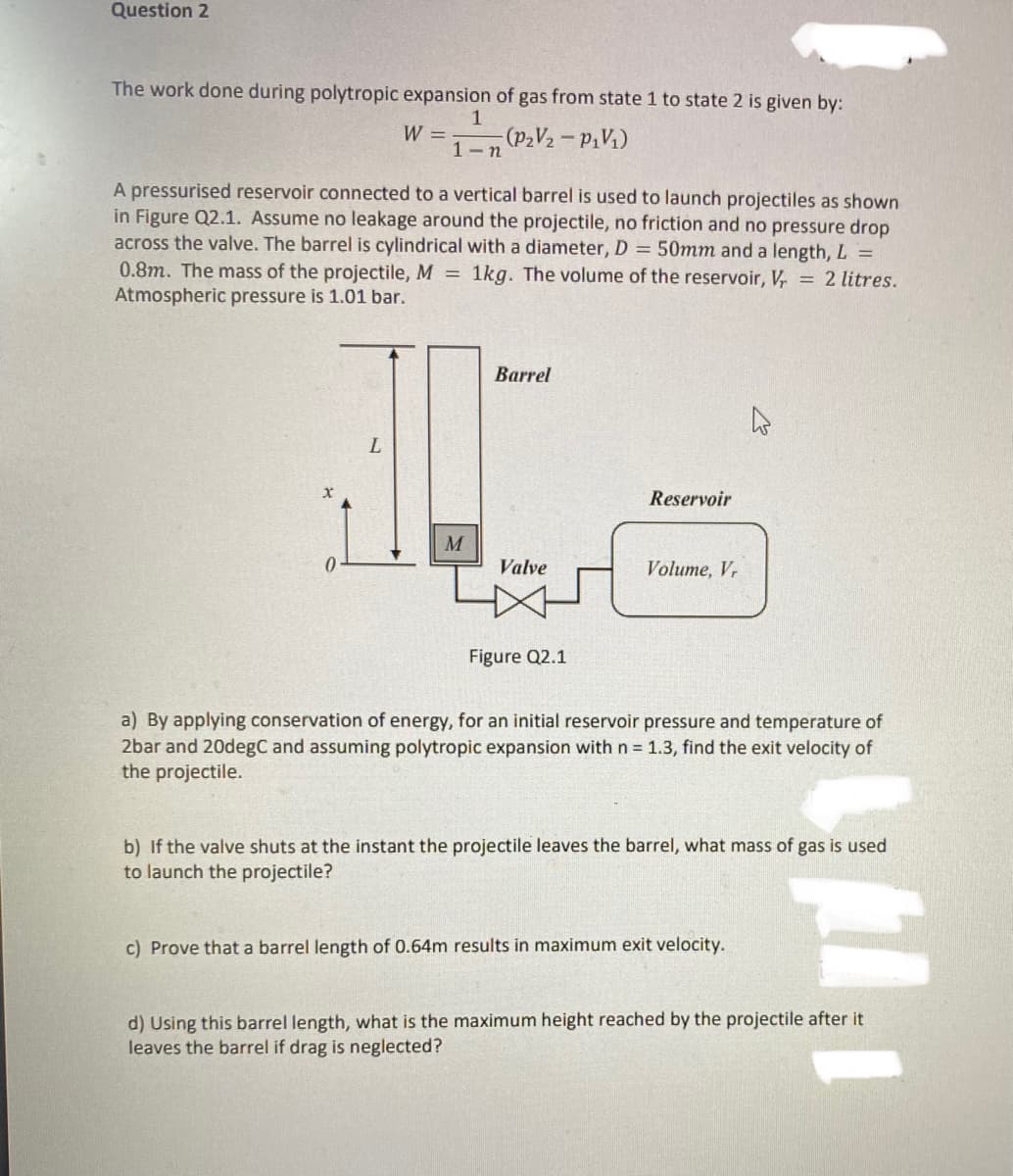The work done during polytropic expansion of gas from state 1 to state 2 is given by: 1 W = - (P₂V₂ - P₁V₁) 1-n A pressurised reservoir connected to a vertical barrel is used to launch projectiles as shown in Figure Q2.1. Assume no leakage around the projectile, no friction and no pressure drop across the valve. The barrel is cylindrical with a diameter, D = 50mm and a length, L = 0.8m. The mass of the projectile, M = 1kg. The volume of the reservoir, V = 2 litres. Atmospheric pressure is 1.01 bar. L M Barrel Valve Figure Q2.1 Reservoir Volume, Vr a) By applying conservation of energy, for an initial reservoir pressure and temperature of 2bar and 20degC and assuming polytropic expansion with n= 1.3, find the exit velocity of the projectile. b) If the valve shuts at the instant the projectile leaves the barrel, what mass of gas is used to launch the projectile? c) Prove that a barrel length of 0.64m results in maximum exit velocity. d) Using this barrel length, what is the maximum height reached by the projectile after it leaves the barrel if drag is neglected?
The work done during polytropic expansion of gas from state 1 to state 2 is given by: 1 W = - (P₂V₂ - P₁V₁) 1-n A pressurised reservoir connected to a vertical barrel is used to launch projectiles as shown in Figure Q2.1. Assume no leakage around the projectile, no friction and no pressure drop across the valve. The barrel is cylindrical with a diameter, D = 50mm and a length, L = 0.8m. The mass of the projectile, M = 1kg. The volume of the reservoir, V = 2 litres. Atmospheric pressure is 1.01 bar. L M Barrel Valve Figure Q2.1 Reservoir Volume, Vr a) By applying conservation of energy, for an initial reservoir pressure and temperature of 2bar and 20degC and assuming polytropic expansion with n= 1.3, find the exit velocity of the projectile. b) If the valve shuts at the instant the projectile leaves the barrel, what mass of gas is used to launch the projectile? c) Prove that a barrel length of 0.64m results in maximum exit velocity. d) Using this barrel length, what is the maximum height reached by the projectile after it leaves the barrel if drag is neglected?
Elements Of Electromagnetics
7th Edition
ISBN:9780190698614
Author:Sadiku, Matthew N. O.
Publisher:Sadiku, Matthew N. O.
ChapterMA: Math Assessment
Section: Chapter Questions
Problem 1.1MA
Related questions
Question

Transcribed Image Text:Question 2
The work done during polytropic expansion of gas from state 1 to state 2 is given by:
W =
(P₂V₂ - P₁V₁)
1-n
A pressurised reservoir connected to a vertical barrel is used to launch projectiles as shown
in Figure Q2.1. Assume no leakage around the projectile, no friction and no pressure drop
across the valve. The barrel is cylindrical with a diameter, D = 50mm and a length, L =
0.8m. The mass of the projectile, M = 1kg. The volume of the reservoir, V = 2 litres.
Atmospheric pressure is 1.01 bar.
0
L
M
Barrel
Valve
Figure Q2.1
Reservoir
Volume, Vr
a) By applying conservation of energy, for an initial reservoir pressure and temperature of
2bar and 20degC and assuming polytropic expansion with n = 1.3, find the exit velocity of
the projectile.
b) If the valve shuts at the instant the projectile leaves the barrel, what mass of gas is used
to launch the projectile?
c) Prove that a barrel length of 0.64m results in maximum exit velocity.
d) Using this barrel length, what is the maximum height reached by the projectile after it
leaves the barrel if drag is neglected?
Expert Solution
This question has been solved!
Explore an expertly crafted, step-by-step solution for a thorough understanding of key concepts.
Step by step
Solved in 4 steps with 1 images

Knowledge Booster
Learn more about
Need a deep-dive on the concept behind this application? Look no further. Learn more about this topic, mechanical-engineering and related others by exploring similar questions and additional content below.Recommended textbooks for you

Elements Of Electromagnetics
Mechanical Engineering
ISBN:
9780190698614
Author:
Sadiku, Matthew N. O.
Publisher:
Oxford University Press

Mechanics of Materials (10th Edition)
Mechanical Engineering
ISBN:
9780134319650
Author:
Russell C. Hibbeler
Publisher:
PEARSON

Thermodynamics: An Engineering Approach
Mechanical Engineering
ISBN:
9781259822674
Author:
Yunus A. Cengel Dr., Michael A. Boles
Publisher:
McGraw-Hill Education

Elements Of Electromagnetics
Mechanical Engineering
ISBN:
9780190698614
Author:
Sadiku, Matthew N. O.
Publisher:
Oxford University Press

Mechanics of Materials (10th Edition)
Mechanical Engineering
ISBN:
9780134319650
Author:
Russell C. Hibbeler
Publisher:
PEARSON

Thermodynamics: An Engineering Approach
Mechanical Engineering
ISBN:
9781259822674
Author:
Yunus A. Cengel Dr., Michael A. Boles
Publisher:
McGraw-Hill Education

Control Systems Engineering
Mechanical Engineering
ISBN:
9781118170519
Author:
Norman S. Nise
Publisher:
WILEY

Mechanics of Materials (MindTap Course List)
Mechanical Engineering
ISBN:
9781337093347
Author:
Barry J. Goodno, James M. Gere
Publisher:
Cengage Learning

Engineering Mechanics: Statics
Mechanical Engineering
ISBN:
9781118807330
Author:
James L. Meriam, L. G. Kraige, J. N. Bolton
Publisher:
WILEY